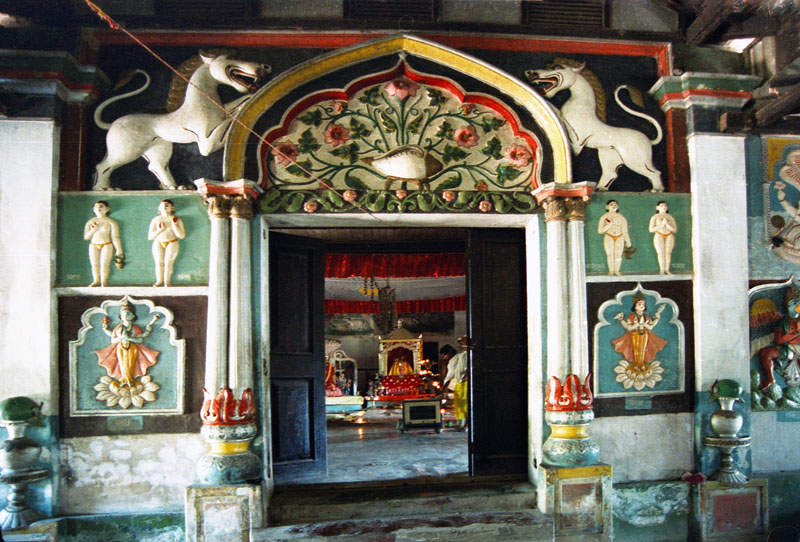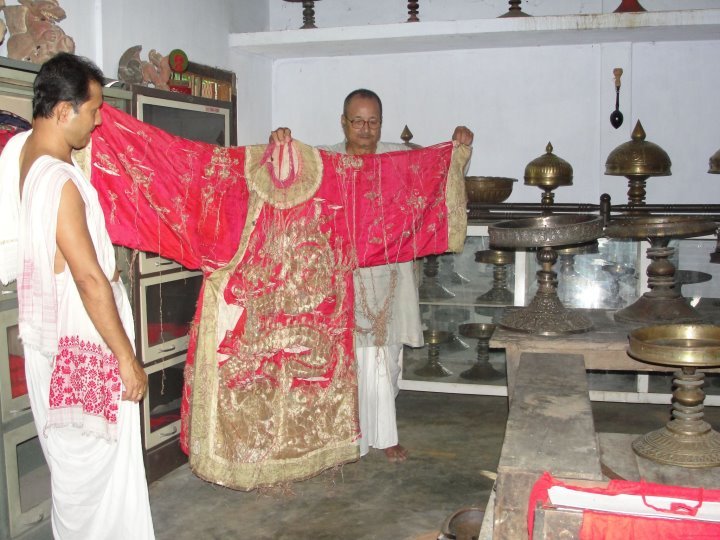|
Joymoti (1935 Film)
''Joymoti'' or ''Joimoti'' ( as, জয়মতী), released on 10 March 1935, was the first Assamese film made. Based on Lakshminath Bezbaroa's play about the 17th-century Ahom princess Soti Joymoti, the film was produced and directed by the noted Assamese poet, author, and film-maker Jyoti Prasad Agarwala, and starred Aideu Handique and acclaimed stage actor and playwright Phani Sarma. The film, shot between 1933 and 1935, was released by Chitralekha Movietone in 1935 and marked the beginning of Assamese cinema. ''Joymoti'' was screened at the 50th International Conference of the Society For Cinema and Media Studies (SCMC) of Northwestern University in Evanston, Illinois, United States in March 2011. Other screenings include: * India-Bangladesh Joint Celebration of 100 Years of Indian Cinema, Dhaka (2012) * UCLA's Centre for India and South Asia Studies, Los Angeles (April 2010) * Osian-Cinefan's 10th Film Festival of Asian and Arabic Cinema, New Delhi (2008) * Filmbüro ... [...More Info...] [...Related Items...] OR: [Wikipedia] [Google] [Baidu] |
Jyoti Prasad Agarwala
Jyoti Prasad Agarwala (2 July 1903 – 17 January 1951) was a noted Indian playwright, songwriter, poet, writer and film maker from Assam. He was considered as Assamese cultural icon, deeply revered for his creative vision and output and is popularly called the ''Rupkonwar'' of Assamese culture. In fact, he is regarded as the founder of Assamese cinema for '' Joymoti'' (1935). His death anniversary (17 January) is observed as ''Silpi divas'' (Artists' Day) his honor. Biography Jyoti Prasad Agarwala was born on 02 July 1903 to an Agrawal family, to Paramananda Agarwala and Kiranmoyee Devi at Tamulbari Tea Estate. His uncles were renowned Assamese poets Chandra Kumar Agarwala and Ananda Chandra Agarwala. His forefather, Nabrangram Agarwala, had come to Assam in 1811 from the Marwar region in Rajasthan. After completing his studies in various schools in Assam and Calcutta, he matriculated in 1921. He went to Edinburgh in 1926 to study economics, but returned in 1930 before com ... [...More Info...] [...Related Items...] OR: [Wikipedia] [Google] [Baidu] |
Russia
Russia (, , ), or the Russian Federation, is a List of transcontinental countries, transcontinental country spanning Eastern Europe and North Asia, Northern Asia. It is the List of countries and dependencies by area, largest country in the world, with its internationally recognised territory covering , and encompassing one-eighth of Earth's inhabitable landmass. Russia extends across Time in Russia, eleven time zones and shares Borders of Russia, land boundaries with fourteen countries, more than List of countries and territories by land borders, any other country but China. It is the List of countries and dependencies by population, world's ninth-most populous country and List of European countries by population, Europe's most populous country, with a population of 146 million people. The country's capital and List of cities and towns in Russia by population, largest city is Moscow, the List of European cities by population within city limits, largest city entirely within E ... [...More Info...] [...Related Items...] OR: [Wikipedia] [Google] [Baidu] |
A Scene From Joymoti (1935 Film)
A, or a, is the first letter and the first vowel of the Latin alphabet, used in the modern English alphabet, the alphabets of other western European languages and others worldwide. Its name in English is ''a'' (pronounced ), plural ''aes''. It is similar in shape to the Ancient Greek letter alpha, from which it derives. The uppercase version consists of the two slanting sides of a triangle, crossed in the middle by a horizontal bar. The lowercase version can be written in two forms: the double-storey a and single-storey ɑ. The latter is commonly used in handwriting and fonts based on it, especially fonts intended to be read by children, and is also found in italic type. In English grammar, " a", and its variant " an", are indefinite articles. History The earliest certain ancestor of "A" is aleph (also written 'aleph), the first letter of the Phoenician alphabet, which consisted entirely of consonants (for that reason, it is also called an abjad to distinguish it fro ... [...More Info...] [...Related Items...] OR: [Wikipedia] [Google] [Baidu] |
Guwahati
Guwahati (, ; formerly rendered Gauhati, ) is the biggest city of the Indian state of Assam and also the largest metropolis in northeastern India. Dispur, the capital of Assam, is in the circuit city region located within Guwahati and is the seat of the Government of Assam. A major riverine port city along with hills, and one of the fastest growing cities in India, Guwahati is situated on the south bank of the Brahmaputra. It is called the ''Gateway to North East India''. The ancient cities of Pragjyotishpura and Durjaya (North Guwahati) were the capitals of the ancient state of Kamarupa. Many ancient Hindu temples like the Kamakhya Temple, Ugratara Devalaya, Ugratara Temple, Basistha Temple, Doul Govinda Temple, Umananda Temple, Navagraha temples#Navagraha Temple in Assam, Navagraha Temple, Sukreswar Temple, Rudreswar Temple, Manikarneswar Temple, Aswaklanta Temple, Dirgheshwari temple, Dirgheshwari Temple, Asvakranta Temple, Lankeshwar Temple, Bhubaneswari Temple, Shree Gane ... [...More Info...] [...Related Items...] OR: [Wikipedia] [Google] [Baidu] |
Lakshminath Bezbarua
' Lakshminath Bezbarua (, 14 October 1864), was an Assamese poet, novelist and playwright of modern Assamese literature. He was one of the literary stalwarts of the Jonaki Era, the age of romanticism in Assamese literature when through his essays, plays, fiction, poetry and satires, he gave a new impetus to the then stagnating Assamese literary caravan. He responded to the prevailing social environment through his satirical works to bring and sustain positive changes to the former. His literature reflected the deeper urges of the people of Assam. Confusion regarding date of birth There is confusion regarding the date of birth of Bezbaroa and also a story behind it as told by Bezbaroa himself. In the first line of the first paragraph of the first chapter of his auto-biography ''Mor Jiban Xuworon'' (মোৰ জীৱন সোঁৱৰণ), Bezbaroa confirms outright his inability to remember his exact date of birth that his parents used to tell him. But later when he grew you ... [...More Info...] [...Related Items...] OR: [Wikipedia] [Google] [Baidu] |
Sattra
Satras are institutional centers associated with the Ekasarana tradition of Vaishnavism, largely found in the Indian state of Assam and neighboring regions. Numbering in the hundreds, these centers are generally independent of each other and under the control of individual ''adhikaras'' (or ''satradhikars''), though they can be grouped into four different ''Sanghatis'' (orders). These centers, in the minimum, maintain a prayer house (''Namghar'', or '' Kirtan-ghar''), initiate lay people into the Ekasarana tradition and include them as disciples of the Satra from whom taxes and other religious duties are extracted. The Neo-Vaishnavite satra culture started in the 16th century. They grew rapidly in the 17th century and patronage extended to them by first the Koch kingdom and later the Ahom kingdom was crucial in the spread the Ekasarana religion. Many of the larger Satras house hundreds of celibate and non-celibate ''bhakats'' (monks), hold vast lands and are repositories of r ... [...More Info...] [...Related Items...] OR: [Wikipedia] [Google] [Baidu] |
Laluksola Borphukan
Laluksola Borphukan (fl. 1672–1680) Laluk Nimati Phukan elder brother of Lachit Borphukan succeed the seat of Borphukan after demise of his younger brother Lachit Phukan, Laluksola Borphukan, who abandoned Guwahati, and aspired to be a king. He was appointed the Borphukan by Udayaditya Singha after the death of his younger brother and predecessor, Lachit Borphukan Lachit Barphukan was an Ahom commander, known for his leadership in the Battle of Saraighat that thwarted an invasion by Mughal forces under the command of Ramsingh I. Biography Lachit was born to Momai Tamuli, a commoner who rose to the ran ..., in 1672. He was assassinated by his servent while he was at sleep. Notes References * {{refend People of the Ahom kingdom Ahom kingdom ... [...More Info...] [...Related Items...] OR: [Wikipedia] [Google] [Baidu] |
Sulikphaa
Sulikphaa () also, Ratnadhwaj Singha was the twenty-eighth king of the Ahom Kingdom. He was only 14 years of age when Laluksola Borphukan, the Ahom viceroy of Guwahati and Lower Assam, raised him to the throne, after deposing the former king, Sudoiphaa. Due to his young age at the time of his accession, he was generally known as Lora Raja or the Boy-king. His reign was characterized by the atrocities committed by Laluksola Borphukan, who held the real authority behind the throne, in his name. The most notorious act which occurred during his reign was the mutilation of Ahom princes belonging to different ''phoids'' or clans of the Royal Ahom Dynasty. While most of the Ahom princes suffered mutilation, Prince Gadapani, the future king Gadadhar Singha, from the Tungkhungia branch of the Royal Ahom Dynasty, escaped, due to the efforts of his illustrious wife, Joymoti Konwari, who refused to divulge any information regarding her husband's whereabouts even in face of the tortures infl ... [...More Info...] [...Related Items...] OR: [Wikipedia] [Google] [Baidu] |
Universum Film AG
UFA GmbH, shortened to UFA (), is a film and television production company that unites all production activities of the media conglomerate Bertelsmann in Germany. Its name derives from Universum-Film Aktiengesellschaft (normally abbreviated as ''UFA''), a major German film company headquartered in Babelsberg, producing and distributing motion pictures from 1917 until the end of the Nazi era. The name UFA was revived by Bertelsmann for an otherwise unrelated film and television outfit, UFA GmbH. The original UFA was established as Universum-Film Aktiengesellschaft on December 18, 1917, as a direct response to foreign competition in film and propaganda. UFA was founded by a consortium headed by Emil Georg von Stauß, a former Deutsche Bank board member. In March 1927, Alfred Hugenberg, an influential German media entrepreneur and later Minister of the Economy, Agriculture and Nutrition in Hitler's cabinet, purchased UFA and transferred ownership of it to the Nazi Party in 1933. ... [...More Info...] [...Related Items...] OR: [Wikipedia] [Google] [Baidu] |
Actress Swargajyoti Barooah In Joymoti Film
An actor or actress is a person who portrays a character in a performance. The actor performs "in the flesh" in the traditional medium of the theatre or in modern media such as film, radio, and television. The analogous Greek term is (), literally "one who answers".''Hypokrites'' (related to our word for hypocrite) also means, less often, "to answer" the tragic chorus. See Weimann (1978, 2); see also Csapo and Slater, who offer translations of classical source material using the term ''hypocrisis'' (acting) (1994, 257, 265–267). The actor's interpretation of a rolethe art of actingpertains to the role played, whether based on a real person or fictional character. This can also be considered an "actor's role," which was called this due to scrolls being used in the theaters. Interpretation occurs even when the actor is "playing themselves", as in some forms of experimental performance art. Formerly, in ancient Greece and the medieval world, and in England at the time of Willi ... [...More Info...] [...Related Items...] OR: [Wikipedia] [Google] [Baidu] |
Gadapani
Supaatpha also, Gadadhar Singha (reign 1681–1696) established the rule of the Tungkhungia clan of the Ahom kings that ruled the Ahom kingdom till its climactic end. He was the son of Gobar Roja, a descendant of Suhungmung, and who had become the king for a mere 20 days. Previously known as Godapani, Supatphaa was able to stabilize the kingdom after the decade-long turmoil following the Ahom victory in the Battle of Saraighat. This period saw the ruthless power grab of Debera Borbarua and Laluksola Borphukan's abandonment of Guwahati and oppression via Sulikphaa ''Lora Roja''. Supatphaa retook Guwahati from the Mughals for good, and established a strong rule of 'blood and iron'. He came into conflict with the Mayamara Vaishnava ''sattra'' which belonged to the folds of Kal "songhoti"and made way for Rudra Singha, his son and succeeding king, to take the kingdom to its zenith. Supatphaa shifted the kingdom's capital to Barkola close to Garhgaon. Kinship By his lineage, c ... [...More Info...] [...Related Items...] OR: [Wikipedia] [Google] [Baidu] |







